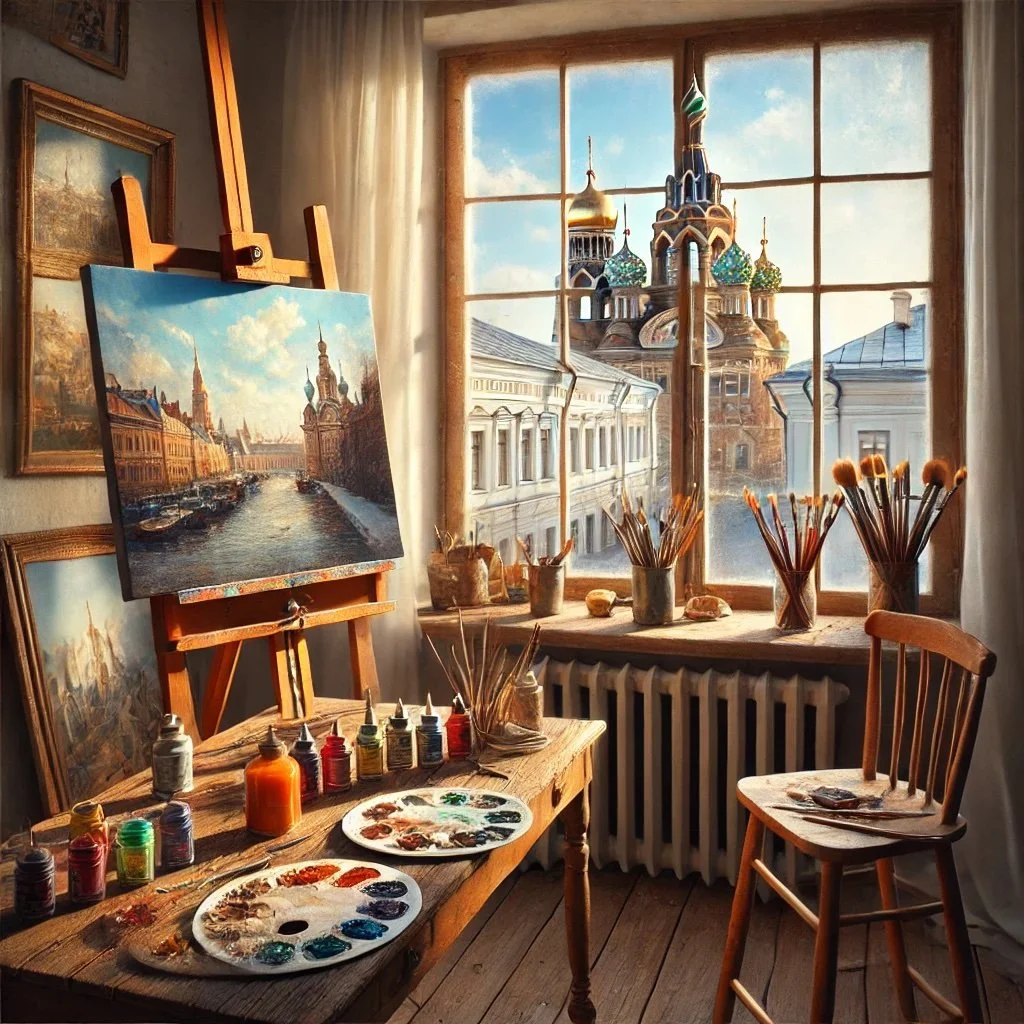Russian Famous Artists: Masters of Russian Art Through the Centuries
Russian art is a breathtaking tapestry of tradition, innovation, and rebellion, shaped by centuries of cultural and political evolution. From the golden hues of Orthodox icons to the bold experiments of the avant-garde, Russian artists have continually pushed the boundaries of artistic expression. Russian famous artists have created works that capture the country’s vast landscapes, historic struggles, and the deep emotions of its people, making Russian art an essential part of world heritage.
Russian painters have long drawn inspiration from the country’s unique blend of Eastern and Western influences. Early Russian art was dominated by iconography, reflecting the spiritual devotion of Orthodox Christianity. Masters like Andrei Rublev created paintings that were not just religious artifacts but profound expressions of faith and artistic excellence. As Russia modernized, realist painters such as Ilya Repin and Vasily Perov turned their focus to everyday life, capturing the dignity and hardship of Russian peasants, intellectuals, and historical figures.
The turn of the 20th century marked a time of revolution—both in politics and art. Russian painters began to embrace new styles and techniques, giving birth to some of the most influential artistic movements in history. Symbolism, led by artists like Mikhail Vrubel, introduced mysticism and dreamlike imagery, while Viktor Vasnetsov revived medieval and folklore themes, crafting mythological masterpieces. Then came the Russian avant-garde, spearheaded by artists such as Kazimir Malevich, Wassily Kandinsky, and Marc Chagall, who radically transformed the art world with abstract compositions, geometric forms, and bold colors. Their work laid the foundation for modernist movements across Europe and beyond.
The evolution of Russian famous artists is deeply tied to the country's political and social transformations. Art was often used as a tool for ideological messaging, with Soviet-era painters like Aleksandr Deyneka creating propaganda-infused works celebrating industrial progress and the Soviet worker. Despite this, many Russian artists continued to explore themes of individuality, identity, and human emotion, producing works that resonate with audiences around the world today.
In this article, we will explore the most famous Russian artists, their masterpieces, and their impact on global art history. Whether you are an art enthusiast, a student of Russian culture, or simply someone intrigued by the beauty of Russian creativity, this guide will introduce you to the brilliant minds that have shaped Russian visual arts through the centuries.
Famous Russian Artists and Their Masterpieces
1. Andrei Rublev (1360–1430) – The Master of Icons
Andrei Rublev was a medieval Russian icon painter whose work became a symbol of Orthodox Christianity. His most famous painting, The Trinity, is considered one of the greatest religious artworks in Russian history. Rublev’s use of delicate colors, harmonious composition, and spiritual symbolism set his icons apart from others of his time. His influence was so profound that he was later canonized as a saint by the Russian Orthodox Church. Today, his work continues to be admired in the Tretyakov Gallery in Moscow.
2. Ilya Repin (1844–1930) – The Realist Genius
Ilya Repin was one of the most significant Russian realist painters of the 19th century. His masterpiece, Barge Haulers on the Volga, depicted the harsh realities of laborers struggling under extreme conditions. He was known for his ability to capture emotion, movement, and psychological depth in his portraits and historical scenes. His painting Ivan the Terrible and His Son remains one of the most dramatic and emotionally intense artworks in Russian history. Repin’s dedication to social realism influenced generations of painters after him.
3. Kazimir Malevich (1879–1935) – The Father of Suprematism
Kazimir Malevich was a revolutionary artist who pioneered the Suprematist movement. His most famous work, Black Square, was a radical departure from traditional art, focusing on pure geometric shapes and colors. Malevich believed that art should be free from objects and should instead focus on form and feeling. His abstract approach influenced modern art movements such as minimalism and constructivism. Despite facing censorship under Soviet rule, his ideas remain central to contemporary discussions of abstraction in art.
4. Marc Chagall (1887–1985) – The Poet of Color
Marc Chagall was a Russian-French artist known for his dreamlike and fantastical paintings. His work combined elements of surrealism, Jewish folk traditions, and Russian village life. His famous painting I and the Village is a prime example of his use of bold colors and imaginative storytelling. Chagall also worked extensively in stained glass, producing iconic windows for cathedrals in Europe. His art remains celebrated worldwide for its emotional depth and poetic imagery.
Russian Art and Its Global Influence
Russian art has left a profound and lasting imprint on the global artistic landscape. The contributions of Russian painters, from medieval iconographers to avant-garde revolutionaries, have influenced countless art movements across Europe, America, and beyond. The depth of Russian artistic expression, often reflecting the country's tumultuous history, has made it an essential part of global cultural heritage. Many of the great Russian famous artists not only shaped the artistic movements within their own country but also transformed international art scenes, inspiring generations of artists, critics, and scholars worldwide.
One of the key reasons Russian art has resonated globally is its ability to combine deep emotional narratives with innovative techniques. Realist painters like Ilya Repin brought an unparalleled intensity to their works, influencing French Impressionists and American Social Realists who sought to portray the struggles of the working class. The Russian avant-garde movement, led by artists such as Kazimir Malevich, Wassily Kandinsky, and Marc Chagall, played a pivotal role in shaping modernism and abstract art, impacting movements like Bauhaus, Constructivism, and even contemporary minimalism. Malevich’s Black Square is often considered a turning point in the history of abstract painting, leading to a new era where color and form carried meaning beyond figurative representation.
Additionally, the symbolist and folkloric traditions found in the works of Viktor Vasnetsov and Mikhail Vrubel introduced a mythological and fantastical dimension to Russian painting, which later influenced Art Nouveau and Expressionism in Western Europe. The surreal and dreamlike quality of Chagall’s paintings was deeply influential in Parisian art circles, where he worked alongside other pioneers of surrealism and cubism. Russian artists also played a significant role in stage and set design, with figures like Natalia Goncharova and Leon Bakst revolutionizing Ballets Russes, which went on to redefine Western theatrical performances and costume design.
Today, Russian masterpieces are showcased in the most prestigious art institutions worldwide. Museums such as the Tretyakov Gallery in Moscow, the Hermitage Museum in St. Petersburg, the Louvre in Paris, the Tate Modern in London, and the Museum of Modern Art in New York all house iconic works from Russia’s greatest painters. Many modern artists continue to draw inspiration from the rich visual language, storytelling, and experimental spirit of Russian art. From the iconic imagery of Russian Orthodox paintings to the bold, geometric explorations of Soviet Constructivism, Russian art continues to shape the way we perceive beauty, history, and human experience.
If you’re in Berkeley, San Francisco, or Oakland and want to explore Russian art and culture further, learning the Russian language will allow you to appreciate these works in their original context. At Polyglottist Language Academy, we offer Russian classes designed to help students engage with Russian culture, literature, and art more deeply.
✅ Want to explore Russian art and culture more deeply? 🔗 Sign Up for Our Russian Classes Today
More Language Learning Resources
Looking for more ways to enhance your Russian skills? Check out these helpful blog posts:

